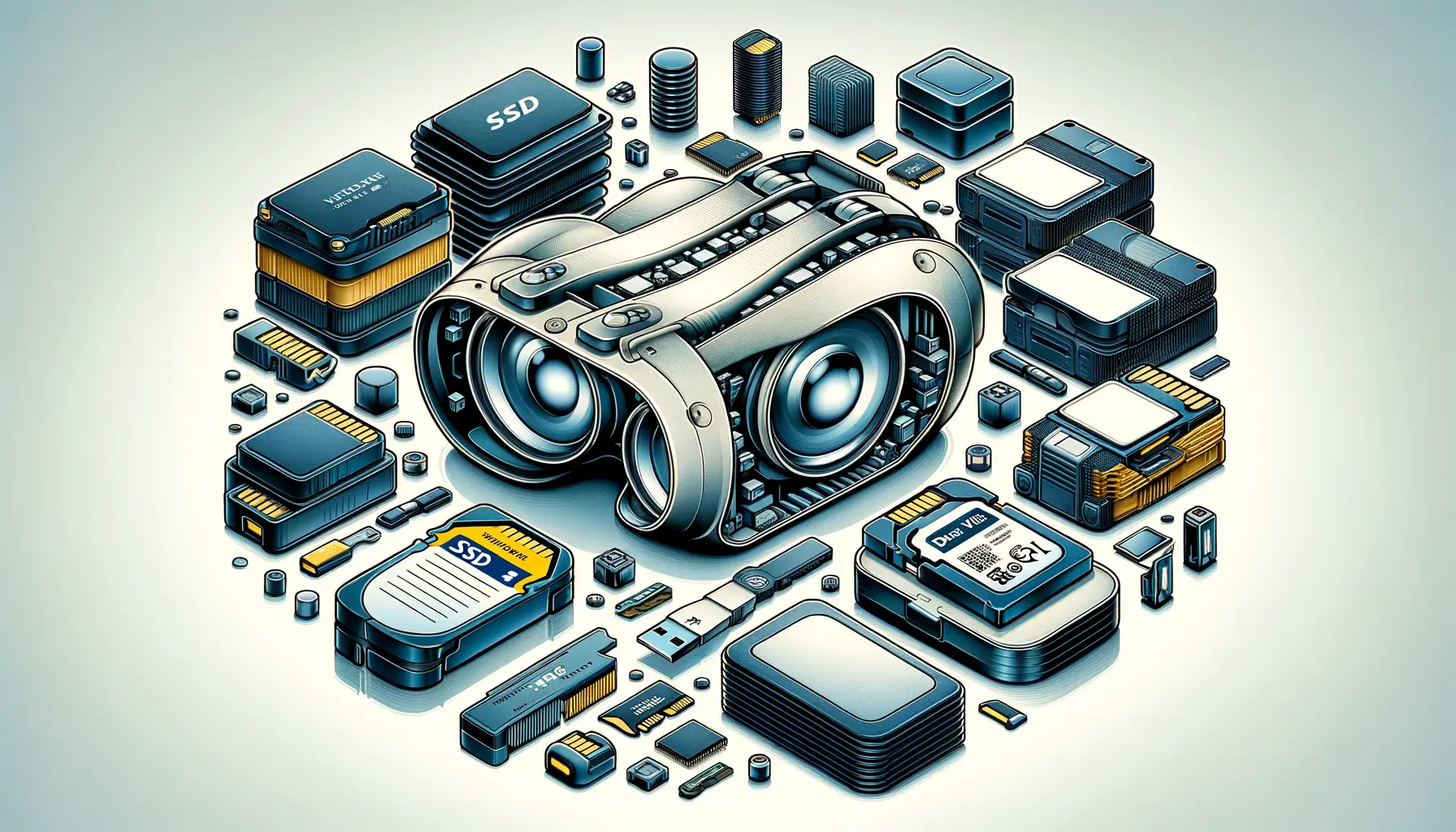The unveiling of Apple Vision Pro marks a significant leap in the realm of technology, intertwining advanced features with the core principle of sustainability.
This innovative product not only showcases Apple’s commitment to pushing the boundaries of what’s possible in tech but also highlights a steadfast dedication to environmental responsibility.
The Apple Vision Pro, as a pioneering device in the tech industry, embodies a future where technology and sustainability are not mutually exclusive but are instead harmoniously integrated.
At the heart of Apple Vision Pro’s development is the company’s long-standing commitment to reducing its carbon footprint and promoting sustainable practices across its product lifecycle.
From design to production, and through to disposal, every aspect of the Apple Vision Pro is meticulously crafted with sustainability in mind.
This approach not only reflects Apple’s environmental ethos but also sets a new standard for the industry, encouraging other companies to follow suit in the pursuit of a more sustainable future.
- The Sustainability of Apple Vision Pro
- Advancements in Sustainable Packaging
- Energy Efficiency and User Experience
- Renewable Energy in Production
- Impact on Ecosystem and Biodiversity
- Community Engagement and Sustainability Education
- Innovative Technologies for Sustainability
- Embracing Sustainability Through Innovation: The Apple Vision Pro Journey
- FAQs on the Sustainability of Apple Vision Pro
The Sustainability of Apple Vision Pro
Recycled Materials in Design
The Apple Vision Pro’s commitment to sustainability is evident right from its construction.
Utilizing 14 percent recycled content, the device features a 100 percent recycled aluminum frame and battery enclosure.
This not only reduces the demand for virgin aluminum, which has a high carbon footprint due to its production process, but also showcases Apple’s innovative approach to reusing materials.
By prioritizing recycled materials, Apple Vision Pro sets a precedent for environmental responsibility in the tech industry.
Moreover, the use of recycled content extends beyond aluminum.
The Vision Pro incorporates recycled plastic in certain components, further emphasizing Apple’s commitment to minimizing its environmental impact.
This strategic use of materials not only conserves natural resources but also reduces the overall carbon emissions associated with the production of new plastic and metal materials.
Energy Efficiency and Carbon Neutrality
Energy efficiency is another cornerstone of the Apple Vision Pro’s sustainability.
Apple’s efforts to ensure that the Vision Pro is as energy-efficient as possible reflect a broader commitment to reducing the environmental impact of their products.
By optimizing software and hardware to consume less power, the Vision Pro not only offers an exceptional user experience but also contributes to lower energy consumption, which is crucial in the fight against climate change.
In line with its goal of achieving carbon neutrality across its entire business, Apple has also made significant strides in ensuring that the production of the Vision Pro is powered by 100% renewable electricity.
This commitment extends to Apple’s suppliers, many of whom have pledged to use renewable energy for Apple production.
This not only reduces the carbon footprint of the Vision Pro but also encourages a shift towards greener energy sources within the tech industry’s supply chain.
The Apple Vision Pro exemplifies how cutting-edge technology can be designed and produced in an environmentally sustainable manner, setting a benchmark for future products in the tech industry.
Advancements in Sustainable Packaging
Apple’s innovation in sustainability extends beyond the product itself to its packaging.
The company has made significant strides in reducing the environmental impact of its packaging for the Apple Vision Pro.
This effort is part of a broader initiative to minimize waste and promote recycling across all its product lines.
One of the key features of the Vision Pro’s packaging is its reliance on recycled and renewable materials.
Apple has meticulously designed the packaging to be as minimal and efficient as possible, reducing the use of plastics and opting for more sustainable options wherever feasible.
This approach not only lessens the environmental footprint of the packaging but also sets a standard for the industry’s move towards greener packaging solutions.
Reducing Plastic Use
In a bold move to combat plastic pollution, Apple has significantly reduced the use of plastic in the Vision Pro’s packaging.
By substituting plastic components with those made from recycled paper or bio-based materials, Apple is not just reducing its reliance on fossil fuel-derived products but also encouraging the development of a market for recycled materials.
This initiative is a testament to Apple’s commitment to circular economy principles, aiming to keep resources in use for as long as possible.
Enhancing Recyclability
Apple has also focused on enhancing the recyclability of the Vision Pro’s packaging.
The design prioritizes materials that can be easily recycled, ensuring that the packaging can be processed through standard recycling facilities.
This consideration for the end-of-life phase of the product’s packaging demonstrates Apple’s holistic approach to sustainability, considering the entire lifecycle of its products and their impact on the environment.
- Use of recycled paper for packaging materials
- Elimination of plastic wraps in favor of paper-based alternatives
- Design for easier disassembly and sorting in recycling processes
Apple’s efforts in sustainable packaging for the Vision Pro highlight the company’s innovative approach to reducing environmental impact, serving as a model for sustainability in the tech industry.
Energy Efficiency and User Experience
The Apple Vision Pro is not just a marvel of technology in terms of its capabilities and design; it also stands out for its energy efficiency.
This aspect is crucial, considering the growing concern over electronic devices’ energy consumption and its impact on the environment.
Apple has addressed these concerns head-on, ensuring that the Vision Pro is as energy-efficient as possible without compromising on user experience.
Energy efficiency in electronic devices like the Vision Pro is achieved through a combination of hardware optimization and intelligent software solutions.
Apple’s approach to this challenge is multifaceted, focusing on reducing power consumption while maintaining high performance.
This balance is key to providing users with a seamless experience that also aligns with sustainability goals.
Optimized Hardware for Lower Energy Consumption
The hardware of the Apple Vision Pro has been meticulously designed to minimize energy consumption.
From the choice of components to their integration, every aspect has been optimized for efficiency.
This includes the use of energy-efficient processors, low-power display technology, and battery management systems that extend the device’s life while reducing the need for frequent charging.
Furthermore, Apple’s commitment to energy efficiency is evident in the Vision Pro’s ability to adjust its performance based on usage patterns.
This dynamic adjustment ensures that the device consumes only as much power as necessary, contributing to overall energy savings.
Software Innovations to Enhance Efficiency
On the software side, Apple Vision Pro benefits from advanced algorithms and operating system optimizations that further reduce energy consumption.
These software solutions manage the device’s resources effectively, ensuring that energy-intensive processes are only activated when needed.
For example, the Vision Pro’s ambient light sensing and automatic brightness adjustment features help conserve battery life by tailoring screen brightness to the environment.
Additionally, Apple has developed features that encourage users to adopt more energy-efficient habits.
These include energy-saving modes that can be activated to extend battery life and notifications that suggest optimal times to charge the device, taking advantage of off-peak energy rates where available.
- Integration of energy-efficient components and technologies
- Dynamic performance adjustment based on usage
- Software optimizations for resource management
- User-centric features to promote energy-saving habits
The energy efficiency of the Apple Vision Pro exemplifies how technology and sustainability can coexist, providing a blueprint for future devices in the industry.
Renewable Energy in Production
The production of Apple Vision Pro is a testament to Apple’s commitment to sustainability, particularly through the use of renewable energy sources.
Recognizing the significant environmental impact associated with manufacturing, Apple has taken bold steps to ensure that its production processes are as green as possible.
This initiative is part of a larger goal to become carbon neutral across all its operations by 2030.
By transitioning to renewable energy for the manufacturing of the Vision Pro, Apple is not only reducing its carbon footprint but also paving the way for a more sustainable tech industry.
This move is crucial in the fight against climate change, as it helps to decrease the reliance on fossil fuels, which are a major source of greenhouse gas emissions globally.
Supplier Commitment to Renewable Energy
A key component of Apple’s strategy is its collaboration with suppliers who are also committed to using 100% renewable energy.
This collective effort amplifies the impact of Apple’s sustainability initiatives, ensuring that the environmental benefits extend throughout the supply chain.
By the end of 2024, Apple aims to have all its products, including the Vision Pro, produced with zero carbon emissions.
The company’s influence has encouraged over 300 suppliers to commit to renewable energy for Apple production, demonstrating the potential for corporate leadership to drive significant environmental change.
This not only benefits the planet but also sets a new standard for sustainability in the tech industry, challenging other companies to follow suit.
Investments in Renewable Energy Projects
Beyond its own operations, Apple is investing in renewable energy projects around the world.
These investments not only contribute to the company’s carbon neutrality goals but also support the broader transition to a green economy.
From solar arrays to wind farms, Apple’s investments are helping to increase the availability of renewable energy, reduce emissions, and create a more sustainable future.
These projects not only supply clean energy for Apple’s manufacturing processes but also provide renewable energy to local communities, demonstrating a commitment to environmental stewardship that goes beyond the company’s immediate needs.
- Transition to 100% renewable energy for manufacturing
- Collaboration with suppliers on renewable energy commitments
- Global investments in renewable energy projects
Apple’s use of renewable energy in the production of the Vision Pro is a clear indication of the company’s dedication to sustainability and its role as a leader in the global shift towards greener manufacturing practices.
Impact on Ecosystem and Biodiversity
The development and production of technological products like the Apple Vision Pro have far-reaching implications for ecosystems and biodiversity.
Apple’s approach to sustainability encompasses not only the reduction of carbon emissions and the use of renewable resources but also a profound consideration for the natural habitats affected by its operations.
This holistic view underlines the importance of preserving biodiversity as a key component of environmental sustainability.
Understanding the interconnectedness of ecosystems, Apple has implemented strategies to minimize its impact on biodiversity.
These efforts are crucial in ensuring that technological advancement does not come at the expense of the planet’s ecological balance.
The company’s initiatives in this area demonstrate a commitment to conservation and sustainable growth.
Responsible Material Sourcing
One of the key strategies employed by Apple to protect ecosystems is responsible material sourcing.
The company ensures that the materials used in products like the Vision Pro are obtained in ways that do not harm the environment.
This includes the use of recycled materials, which reduces the need for mining and other extractive practices that can lead to habitat destruction and biodiversity loss.
Apple’s commitment to responsible sourcing extends to the elimination of conflict minerals from its supply chain.
By ensuring that the materials used in its products do not contribute to environmental degradation or social unrest, Apple upholds its ethical standards while also protecting ecosystems.
Reducing Environmental Footprint
In addition to responsible sourcing, Apple actively works to reduce its overall environmental footprint.
This includes efforts to minimize water usage, reduce waste, and prevent pollution during the manufacturing process.
Such measures are essential for protecting water resources and preventing the contamination of natural habitats.
Apple’s environmental initiatives also include the development of green spaces and wildlife habitats near its facilities.
These efforts contribute to local biodiversity and offer a model for how companies can incorporate ecological considerations into their operations.
- Employment of recycled materials to lessen the need for new resource extraction
- Commitment to eliminating conflict minerals from the supply chain
- Initiatives aimed at reducing water usage and waste production
- Creation of green spaces to support local wildlife and biodiversity
Apple’s proactive measures to minimize its impact on ecosystems and biodiversity through responsible practices and conservation efforts highlight the company’s role as an environmental steward in the tech industry.
Community Engagement and Sustainability Education
Apple’s sustainability efforts extend beyond its immediate operations and product design to include community engagement and education on sustainability issues.
Recognizing the importance of collective action in addressing environmental challenges, Apple actively participates in initiatives that promote awareness and encourage sustainable practices among communities and its user base.
This approach underscores the company’s belief in the power of education and community involvement in fostering a more sustainable future.
Through various programs and partnerships, Apple aims to empower individuals and communities with the knowledge and tools needed to make environmentally responsible choices.
These initiatives not only contribute to the broader goal of sustainability but also help to build a culture of environmental stewardship that can lead to lasting change.
Environmental Education Programs
Apple supports a range of environmental education programs designed to raise awareness about sustainability issues and inspire action.
These programs, often run in partnership with local organizations and schools, provide resources and learning opportunities that highlight the importance of conservation and sustainable living.
By educating the next generation on these critical issues, Apple is investing in a future where technology and environmental responsibility go hand in hand.
The company’s efforts to integrate sustainability into its educational content extend to its software and services.
For example, Apple’s App Store features applications that teach users about renewable energy, recycling, and other environmental topics, making it easier for people to access information and engage with sustainability in their daily lives.
Supporting Local and Global Environmental Initiatives
Beyond education, Apple actively supports local and global environmental initiatives that aim to protect natural resources and combat climate change.
This includes partnerships with conservation organizations, participation in reforestation projects, and contributions to renewable energy funds.
Through these actions, Apple leverages its resources and influence to support efforts that have a positive impact on the planet.
Apple’s commitment to community engagement and sustainability education is also evident in its corporate policies, which encourage employees to participate in environmental volunteerism.
The company offers programs that match employee donations to environmental causes and grants paid time off for volunteering, further embedding sustainability into its corporate culture.
- Development and support of environmental education programs
- Integration of sustainability topics into software and services
- Participation in and support of environmental conservation initiatives
- Encouragement of employee involvement in environmental volunteerism
Through its commitment to community engagement and sustainability education, Apple not only advances its environmental goals but also fosters a broader societal shift towards sustainability, demonstrating the role of corporate leadership in driving positive environmental change.
Innovative Technologies for Sustainability
At the core of Apple’s approach to sustainability is the integration of innovative technologies that not only enhance product performance but also contribute to environmental conservation.
The Apple Vision Pro exemplifies this approach, incorporating cutting-edge features that promote sustainability.
These innovations are a testament to Apple’s commitment to merging technology with environmental responsibility, paving the way for a future where tech advancements are synonymous with ecological stewardship.
The use of such technologies in the Vision Pro and other Apple products reflects a broader strategy to leverage innovation for sustainability.
This strategy is crucial in addressing the environmental challenges of our time, offering solutions that reduce waste, conserve resources, and minimize the carbon footprint of technology products.
Advanced Recycling Techniques
Apple employs advanced recycling techniques to reclaim valuable materials from old devices, reducing the need for new resource extraction and minimizing waste.
The company’s recycling robots, for example, are capable of disassembling products with precision, ensuring that materials such as aluminum, copper, and rare earth elements can be efficiently recovered and reused in new products.
This not only supports the circular economy but also decreases the environmental impact associated with raw material extraction and processing.
Furthermore, Apple’s commitment to recycling extends to its customers through the Apple Trade In program.
This initiative encourages users to recycle their old devices, offering them credit towards new purchases or ensuring responsible recycling if the devices are not eligible for credit.
This program exemplifies how technology can be used to promote sustainability practices among consumers.
Renewable Energy Innovations
Apple’s advancements in renewable energy technologies are another key aspect of its sustainability efforts.
The company invests in and develops innovative solutions to power its operations with clean energy, from solar panels that are more efficient and less intrusive on natural landscapes to wind turbines that maximize energy output while minimizing environmental impact.
These investments not only contribute to Apple’s own sustainability goals but also advance the renewable energy sector as a whole, driving down costs and increasing accessibility for others.
In addition to harnessing renewable energy for its operations, Apple also explores ways to improve energy storage and management.
This includes the development of battery technologies that are more efficient, durable, and environmentally friendly.
Such innovations are critical for the broader adoption of renewable energy, as they address challenges related to energy reliability and storage capacity.
- Utilization of advanced recycling technologies for material recovery
- Encouragement of consumer participation in recycling through trade-in programs
- Investment in renewable energy technologies and infrastructure
- Development of innovative energy storage and management solutions
Contrary to common misconceptions, technological advancement and environmental sustainability are not mutually exclusive. Apple’s innovative approaches in the Vision Pro and beyond demonstrate that technology can be a powerful ally in the quest for a more sustainable future.
Embracing Sustainability Through Innovation: The Apple Vision Pro Journey
The journey of the Apple Vision Pro is a compelling narrative of how technological innovation and environmental sustainability can coalesce to create products that are not only groundbreaking in functionality but also exemplary in ecological responsibility.
This exploration into the sustainability of Apple Vision Pro reveals a multifaceted approach, where every aspect of the product’s lifecycle, from design and production to packaging and disposal, is infused with a commitment to minimizing environmental impact.
Apple’s efforts underscore the potential for technology to lead the way in sustainable development, offering valuable lessons for the industry and consumers alike.
Setting New Standards for Sustainable Technology
The Apple Vision Pro stands as a beacon of sustainable technology, challenging prevailing norms and setting new benchmarks for the industry.
Through its use of recycled materials, energy-efficient design, and renewable energy in production, Apple not only demonstrates its dedication to sustainability but also raises the bar for what consumers can expect from high-tech products.
The Vision Pro’s journey from concept to consumer showcases a blueprint for integrating environmental considerations into every stage of product development, highlighting the importance of sustainability in driving innovation.
Driving Change Beyond the Product
Apple’s commitment to sustainability extends beyond the Vision Pro itself, influencing the broader ecosystem of suppliers, consumers, and communities.
By advocating for renewable energy, advancing recycling technologies, and engaging in community education, Apple catalyzes change across the supply chain and encourages a collective shift towards more sustainable practices.
This holistic approach amplifies the impact of Apple’s sustainability efforts, contributing to a more environmentally conscious society.
- Advancement of recycling and renewable energy technologies
- Engagement in community and educational initiatives for sustainability
- Collaboration with suppliers to adopt greener practices
In conclusion, the sustainability of Apple Vision Pro is not just about the environmental attributes of a single product; it represents a broader commitment to integrating sustainability into the fabric of technological innovation.
Apple’s journey with the Vision Pro illuminates the path for the tech industry, showing that it is possible to achieve excellence in innovation while also honoring our responsibility to the planet.
As we move forward, the principles demonstrated by the Vision Pro will undoubtedly inspire more companies to embrace sustainability as a core aspect of product development, leading to a future where technology and ecology exist in harmony.
If you're seeking expertise in Apple Search Ads campaigns, visit our service page for professional management!
FAQs on the Sustainability of Apple Vision Pro
Explore common questions about the environmental initiatives and sustainable practices behind Apple Vision Pro.
Apple Vision Pro incorporates 14% recycled content, including 100% recycled aluminum for its frame and battery enclosure.
It features energy-efficient components and software optimizations to reduce power consumption without compromising performance.
Yes, its packaging uses recycled and renewable materials, minimizing plastic use and enhancing recyclability.
Apple aims for all its products, including Vision Pro, to be produced with 100% renewable electricity by the end of 2024.
Apple employs responsible material sourcing and reduces its environmental footprint to protect ecosystems and biodiversity.
Apple supports environmental education programs and participates in local and global initiatives to promote sustainability.
Apple leverages advanced recycling techniques and renewable energy innovations to enhance the sustainability of its products.
Through the Apple Trade In program, consumers can recycle old devices, supporting Apple’s commitment to sustainability.











